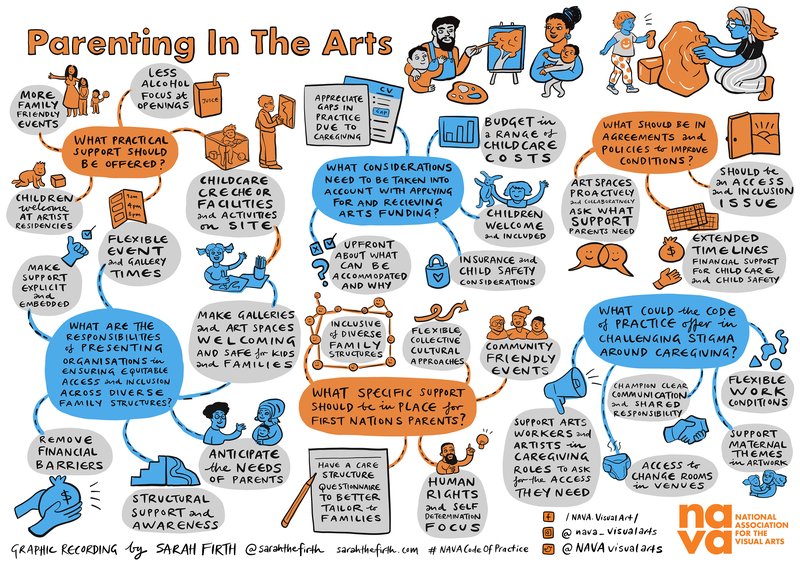Parenting in the Arts: insights from the Code consultation
An overview of NAVA's open consultation.
An overview of NAVA's open consultation.

This week, NAVA held its first Code consultation focused on parenting in the arts. It was encouraging to see so many artists, arts workers, and organisations come together to talk about the challenges of being both an artist and a parent.
This session was part of broader work to update the Code of Practice for Visual Arts, Craft and Design (the Code), which sets out good practice standards for working relationships in the visual arts. It includes ethical approaches to access and inclusion, as well as recommended payment rates for artists and arts workers. A new section on parenting and caregiving is currently being developed.
Future consultations will look more broadly at caregiving, including artists who care for others, those who are supported by carers, and people providing care to artists.
The parenting session began with presentations from artists Nina Ross and April Phillips. Nina shared findings from a 2017 survey she co-led with Jessie Scott and Lizzie Sampson on the experiences of being an artist-parent. The results highlighted a number of major challenges, including limited time for creative practice, financial constraints, social isolation, and the inaccessibility of gallery hours and networking events. The survey also pointed to a lack of support for parental responsibilities, especially for women, sole parents, and primary carers.
Yet Nina also spoke to the adaptability, motivation, and resilience that many artist-parents develop, and urged the arts sector to rethink its structures through a feminist and intersectional lens.
April Phillips reframed parenting as an access issue - one that is often overlooked. Drawing on her own experiences in residencies, she showed how artist-parents can be supported. She praised organisations that embed care, ask the right questions upfront, and offer practical support like flexible timelines and childcare.
Breakout group discussions explored a range of questions, including support for artist-parents in exhibitions, residencies, funding, policy, and agreements, as well as specific support for First Nations artist-parents. Participants called for organisations to ask about care responsibilities early, rather than relying on individuals to disclose or self-advocate. Caring responsibilities should be recognised within access and inclusion frameworks, and built into planning, budgets, timelines and policy.
There was strong support for clearer, more visible support for families. Residencies and galleries, as hosting organisations, should state whether children are welcome onsite and back this up with child-friendly events, dedicated spaces, and practical supports like budgets for carers and childcare. Funding bodies were encouraged to allow for these costs within applications. People also suggested holding openings and events during the day and reducing the focus on alcohol to make them more accessible for families.
At the same time, it was noted that some galleries are already accommodating to children and are open to being led by the artist. For some participants, it was less important for institutions to anticipate every need, and more important that they remain flexible, responsive, and respectful of artist-parents’ choices around how (and whether) their children participate.
The impact of caregiving is not the same for everyone. Gender, family structure, and culture all shape how parenting fits into an artist’s work. Solo parents, First Nations artists, and those with limited support face particular challenges. Many noted that the usual expectations around what an artistic career looks like often don’t match the realities of artist-parents.
Groups also raised concerns about stigma and assumptions about reliability, capacity, and commitment. Too often, parenthood is seen as a disruption rather than a normal part of some artists’ lives and work. Participants called for a shift in thinking and in practice. This includes more welcoming gallery spaces, change rooms, materials for children and young people, and more flexible programs.
NAVA is incredibly grateful to all who contributed. Your insights will help shape a new section for the Code of Practice focused on parenting and caregiving in the visual arts. From here, NAVA will:
If you have notes, reflections, or ideas you’d like to share, please email us at nava@visualarts.net.au. We’d love to hear from you.
Graphic recording by © Sarah Firth.
ID: Mind map using illustrations and text to provide an overview of some of the concerns and recommendations for supporting artist parents during an open NAVA consultation with the sector in August 2025.